ICSE Physics Previous Year Question Paper 2012 Solved for Class 10
ICSE Paper 2012
PHYSICS
(Two hours)
Answers to this Paper must he written on the paper provided separately.
You will not be allowed to write during the first 15 minutes.
This time is to he spent in reading the question paper.
The time given at the head of this Paper is the time allowed for writing the answers.
Section I is compulsory. Attempt any four questions from Section II.
The intended marks for questions or parts of questions are given in brackets [ ].
SECTION-I (40 Marks)
Attempt all questions from this Section.
Question 1:
(a) (i) Define 1 kgf.
(ii) How is it related to the S.I unit of force ? [2]
(b) (i) What are non-contact forces ?
(ii) How does the distance of separation between two bodies affect the magnitude of the non-contact force between them ? [2]
(c) A boy of mass 30 kg is sitting at a distance of 2m from the middle of a see-saw. Where should a boy of mass 40 kg sit so as to balance the see-saw ? [2]
(d) (i) What is meant by the term ‘moment of force’ ?
(ii) If the moment of force is assigned a negative sign then will the turning tendency of the force be clockwise or anticlockwise ? [2]
(e) A ball is placed on a compressed spring. When the spring is released, the ball is observed to fly away.

(i) What form of energy does the compressed spring possess ?
(ii) Why does the ball fly away ? [2]
Answer:
(a) (i) 1 kgf is the force with which earth pulls an object of mass 1 kg towards itself.
(ii) 1 kgf = 9.8 N.
(b) (i) The forces which are applied from a distance, without actually touching the body are called non-contact forces.
(ii) As distance of separation increases, magnitude of non-contact force decreases.
(c) Let the distance of 40 kg. from the mean position be ‘x’ m.
Using principle of moments,
30 × 2 = 40 × x
∴ x = 1.5 m.
(d) (i) Turning effect of force acting on a body about an axis is called moment of force. It is equal to the product of magnitude of force and the perpendicular distance of the line of action of force from the axis of rotation.
(ii) Clockwise.
(e) (i) Potential Energy
(ii) Since P.E. is converted into K.E which transferred to the ball and makes the ball flyaway.
Question 2:
(a) (i) State the energy conversion taking place in a solar cell.
(ii) Give one disadvantage of using a solar cell. [2]
(b) A body of mass 0.2 kg falls from a height of 10m to a height of 6m above the ground. Find the loss in potential energy taking place in the body, [g = 10 ms-2] [2]
(c) (i) Define the term refractive index of a medium in terms of velocity of light.
(ii) A ray of light moves from rare medium to a dense medium as shown in diagram below. Write down the number of the ray which represents the partially reflected ray. [2]

(d) You are provided with a printed piece of paper. Using this paper how will you differentiate between a convex lens and a concave lens ? [2]
(e) A ray of light incident at an angle of incidence V passes through an equilateral glass prism such that the refracted ray inside the prism is parallel to its base and emerges from the prism at an angle of emergence ‘e’.
(i) How is the angle of emergence ‘e’ related to the angle of incidence ‘i’ ?
(ii) What can you say about the value of the angle of deviation in such a situation ? [2]
Answer:
(a) (i) Solar energy to Electrical energy.
(ii) Solar cell is not a constant source of energy.
(b)

(c) (i) The absolute refractive index of a medium is defined as the ratio of the speed of light in vacuum (or air) to the speed of light in that medium i.e.,
\(\mu =\frac { c }{ v } \)
(ii) Ray 2
(d) On moving the printed piece of paper before the lens, if the image is always diminished then it is a concave lens otherwise it is a convex lens.
(e) (i) Angle of incident ∠i = Angle of emergence ∠e

(ii) The angle of deviation is the angle of minimum deviation.
Question 3:
(a) (i) What is meant by ‘Dispersion of light’ ?
(ii) In the atmosphere which colour of light gets scattered the least ? [2]
(b) Which characteristic of sound will change if there is a change in
(i) its amplitude.
(ii) its waveform. [2]
(c) (i) Name one factor which affects the frequency of sound emitted due to vibrations in an air column.
(ii) Name the unit used for measuring the sound level. [2]
(d) An electrical appliance is rated at 1000 KVA, 220V. If the appliance is operated for 2 hours, calculate the energy consumed by the appliance in :
(i) kWh (ii) joule [2]
(e) Calculate the equivalent resistance between P and Q from the following diagram: [2]

Answer:
(a) (i) The phenomenon of splitting of white light of a prism into its constituent colours is called dispersion of light.
(ii) Red colour.
(b) (i) Loudness.
(ii) Quality or Timbre.
(c) (i) Length of air column.
(ii) Decibel
(d) (i) Let Energy consumed = Power × Time
= 1000 × 2 = 2000 kWh
(ii) Since 1 kWh = 3.6 × 106 J
Energy consumed = 2000 × 3.6 × 106 J
= 7.2 × 109 J.
(e) The two 10Ω resistors are in series and they are parallel to the 5Ω resistor.

Question 4:
(a) (i) What is an a.c. generator or Dynamo used for ?
(ii) Name the principle on which it works. [2]
(b) Differentiate between heat capacity and specific heat capacity. [2]
(c) A hot solid of mass 60g at 100°C is placed in 150 g of water at 20°C. The final steady temperature recorded is 25°C. Calculate the specific heat capacity of the solid. [Specific heat capacity of water = 4200 J kg-1 °C-1] [2]
(d) (i) What is the value of the speed of gamma radiations in air or vacuum ?
(ii) Name a material which exhibits fluorescence when cathode rays fall on it. [2]
(e) Give any two important sources of background radiation. [2]
Answer:
(a) (i) An a.c. generator or Dynamo is used to convert mechanical energy to electrical energy.
(ii) Faraday’s law of Electromagnetic induction.
(b) (i) Specific heat capacity is defined on unit mas’s but heat capacity is defined on entire mass.
(ii) Specific heat capacity depends on the mass of the body but heat capacity does not depend on the mass of the body.
(c)

(d) (i) Speed of gamma radiations in air = 3 x 108 ms-1.
(ii) Zinc Sulphide
(e) Two sources of background radiation: K – 40 and C – 14
SECTION-II (40 Marks)
Attempt any four questions from this Section.
Question 5:
(a) (i) Which of the following remains constant in uniform circular motion : Speed or Velocity or both ?
(ii) Name the force required for uniform circular motion. State its direction. [3]
(b) (i) State the class of levers and the relative positions of load (L), effort (E) and fulcrum (F) in each of the following cases :
1. A bottle opener.
2. Sugar tongs.
(ii) Why is less effort needed to lift a load over an inclined plane as compared to lifting the load directly ? [3]
(c) (i) A moving body weighing 400 N possesses 500 J of kinetic energy. Calculate the velocity with which the body is moving. (g = 10 ms-2)
(ii) Under what condition will a set of gears produce :
1. a gain in speed.
2. a gain in torque. [4]
Answer:
(a) (i) Speed remains constant.
(ii) Centripetal force directed towards the centre of the circle.
(b) (i)

(ii) Less effort is required because mechanical advantage increases.
(c) (i)

(ii) (1) For gain in speed: No. of teeth in driving wheel is greater than no. of teeth in driven wheel.
(2) For gain in torque: No. of teeth in driven wheel is greater than no. of teeth in driving wheel.
Question 6:
(a) (i) What is meant by the term ‘critical angle’ ?
(ii) How is it related to the refractive index of the medium ?
(iii) Does the depth of a tank of water appear to change or remain the same when viewed normally from above ?
(b) A ray of light PQ is incident normally on the hypotenuse of a A right angled prism ABC as shown in the diagram given below:
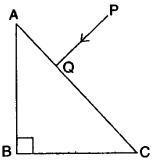
(i) Copy the diagram and complete the path of the ray PQ till it emerges from the prism.
(ii) What is the value of the angle of deviation of the ray ? B
(iii) Name an instrument where this action of the prism is used. [3]
(c) A converging lens is used to obtain an image of an object placed in front of it. The inverted image is formed between F2 and 2F2 of the lens.
(i) Where is the object placed ?
(ii) Draw a ray diagram to illustrate the formation of the image obtained. [4]
Answer:
(a) (i) Critical angle is the angle of incidence in the denser medium corresponding to which the angle of refraction in the rarer medium is 90°.
(ii) aμg = cosec ic where ic in the critical angle.
(iii) Depth remain the same. Apparent depth = Actual depth.
(b) (i)

(ii) Angle of deviation (δ) = 180°
(iii) Prism binocular.
(c) (i) Object is beyond 2F1.
(ii)
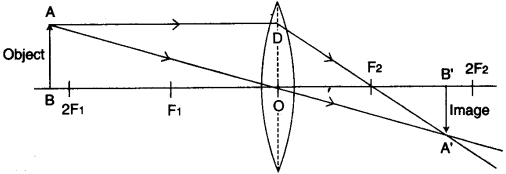
Question 7:
(a) (i) What is meant by Resonance ?
(ii) State two ways in which Resonance differs from Forced vibrations. [3]
(b) (i) A man standing between two cliffs produces a sound and hears two successive echoes at intervals of 3s and 4s respectively. Calculate the distance between the two cliffs.
The speed of sound in the air is 330 ms-1.
(ii) Why will an echo not be heard when the distance between the source of sound and the reflecting surface is 10 m? [3]
(c) The diagram below shows the displacement-time graph for a vibrating body.
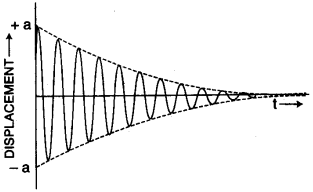
(i) Name the type of vibrations produced by the vibrating body.
(ii) Give one example of a body producing such vibrations.
(iii) Why is the amplitude of the wave gradually decreasing ?
(iv) What will happen to the vibrations of the body after some time ? [4]
Answer:
(a) (i) When the frequency of an externally applied periodic force on a body is equal to the natural frequency of the body, the body readily begins to vibrate or free to vibrate with an increased amplitude. This phenomenon is known as resonance.
(ii)

(b) (i)

(ii) No echo will be heard because least distance of distinct hearing in 17m.
(c) (i) Damped vibrations.
(ii) Tuning fork vibrating in air
(iii) Due to friction, energy is continuously lost.
(iv) After some time, the amplitude gradually decreases and finally stops.
Question 8:
(a) (i) A cell is sending current in an external circuit. How does the terminal voltage compare with the e.m.f. of the cell ?
(ii) What is the purpose of using a fuse in an electrical circuit ?
(iii) What are the characteristic properties of fuse wire ? [3]
(b) (i) Write an expression for the electrical energy spent in the flow of current through an electrical appliance in terms of I, R and t.
(ii) At what voltage is the alternating current supplied to our houses ?
(iii) How should the electric lamps in a building be connected ? [3]
(c) Three resistors are connected to a 6V battery as shown in the figure given below:
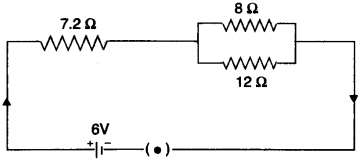
Calculate:
(i) the equivalent resistance of the circuit.
(ii) total current in the circuit.
(iii) potential difference across the 7.2 Ω resistor.
Answer:
(a) (i) Terminal voltage < e.m.f.
(ii) An electric fuse is a safety device which limits the current flowing in an electric circuit.
(iii) A fuse wire must have a High resistance and Low melting point.
(b) (i) We know that E = VIt = I2Rt.
(ii) 220V – 240V
(iii) In a building, Electric lamps are connected in parallel.
(c)
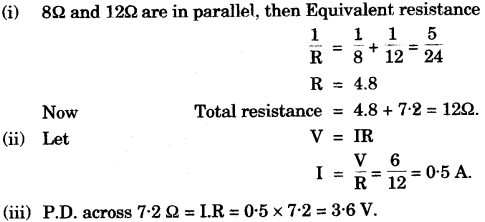
Question 9:
(a) (i) Write an expression for the heat energy liberated by a hot body.
(ii) Some heat is provided to a body to raise its temperature by 25°C. What will be the corresponding rise in temperature of the body as shown on the kelvin scale ?
(iii) What happens to the average kinetic energy of the molecules as ice melts at 0°C ? [3]
(b) A piece of ice at 0°C is heated at a constant rate and its temperature recorded at regular intervals till steam is formed at 100°C. Draw a temperature – time graph to represent the change in phase Label the different parts of your graph. [3]
(c) 40g of ice at 0°C is used to bring down the temperature of a certain mass of water at 60°C to 10°C. Find the mass of water used.
[Specific heat capacity of water = 4200 J kg-1 °C-1.]
[Specific latent heat of fusion of ice – 336 x 103 J kg-1.] [4]
Answer:
(a) (i) ∆Q = mc ∆t
where m —> mass, c —> specific heat capacity, ∆t —> change in temperature.
(ii) Since ∆Q ∝ ∆t
Hence the corresponding rise in temperature of the body in Kelvin = 25K.
(iii) Avg. kinetic energy of the molecules would remain same.
(b)
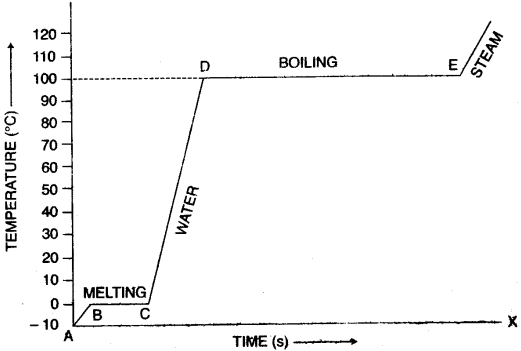
(c)

Question 10:
(a) The diagram below shows a current carrying loop or a circular coil passing through d’sheet of cardboard at the points M and N. The sheet of cardboard is sprinkled uni formly with iron filings.

(i) Copy the diagram and draw an arrow on the circular coil to show the direction of current flowing through it.
(ii) Draw the pattern of arrangement of the iron filings when current is passed through the loop. [3]
(b) (i) Draw a simplified labelled diagram of a hot cathode ray tube.
(ii) Name a common device where a hot cathode ray tube is used. [3]
(c) A certain nucleus X has a mass number 14 and atomic number 6. The nucleus X changes to 7Y14 after the loss of a particle.
(i) Name the particle emitted.
(ii) Represent this change in the form of an equation.
(iii) A radioactive substance is oxidized. What change would you expect to take place in the nature of its radioactivity ? Give a reason for your answer. [4]
Answer:
(a) (i) M to N
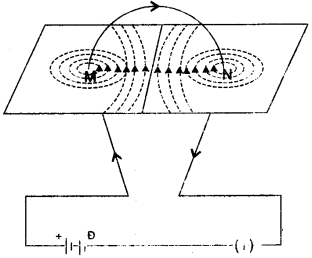
(ii) Anticlockwise around M
Clockwise around N
(b) (i)

(ii) Television Picture Tube.
(c) (i) β particle
(ii)
![]()
(iii) No change because radioactivity is a nuclear phenomenon and oxidation is concerned with outermost orbit.
